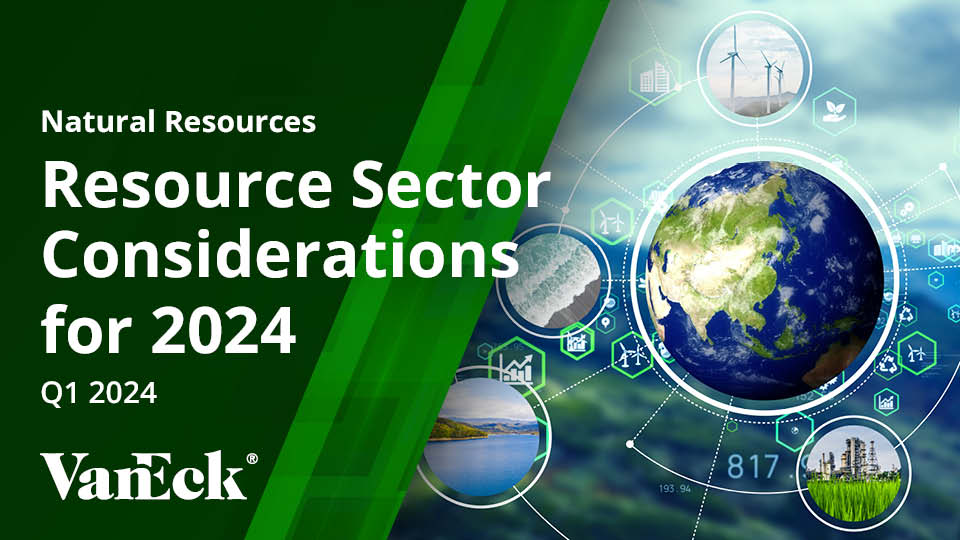3 Reasons to Hold Resource Equities
April 27, 2023
Read Time 2 MIN
Resource equities have experienced a tremendous run over the last several years, with some companies seeing double or even triple-digit gains. For most investors who have been through one or more previous commodity super cycles, this likely feels like an opportune time to take gains and sit back on the sidelines. However, in our view, this is also likely the wrong line of thinking right now from a strategic allocation standpoint. An expanded PDF version of this commentary, including fund specific information can be downloaded here.
- We’re not through the woods yet with inflation – Despite aggressive attempts by the U.S. Federal Reserve (Fed) to combat it, inflation hasn’t fully subsided yet. And while U.S. inflation has come down from highs last seen 40 years ago, it still remains at levels last seen only 32 years ago and well above the Fed’s 2% target. Over this inflation cycle, resource equities have proved – as they have in the past – that they can be an ideal hedge against steadily rising and/or persistently high prices.
- Resource companies are different today – Resource companies have gone to great lengths to mitigate some of the operational and business strategies which often subjected them to greater to boom/bust cycles in the past. In particular, managements have become more financially prudent by foregoing outsized capital expenditure programs, deleveraging their balance sheets and carefully managing their hedging strategies.
- You’re getting paid to wait – While some resource equity companies are cutting back on dividends this year, the amount of anticipated capital return in the space is still significant. In fact, as of end-March, Energy and Materials sectors of the S&P Global 1200 Index – sectors comprising a majority of the resource equity space – continue to boast the highest estimated dividend yields among all other sectors. For investors waiting to redeploy capital, keeping their money parked in resource equities is akin to getting paid to wait.
S&P Global 1200 Sector Dividend Yields
Source: Bloomberg. Data as of March 31, 2023. Indices are not securities in which investments can be made. Past performance is not indicative of future results.
To receive more Natural Resources insights, sign up in our subscription center.
Related Topics
Related Insights
April 15, 2024
March 21, 2024
January 22, 2024
January 16, 2024
Important Disclosure
Please note that VanEck may offer investments products that invest in the asset class(es) or industries included in this blog.
This is not an offer to buy or sell, or a solicitation of any offer to buy or sell any of the securities mentioned herein. The information presented does not involve the rendering of personalized investment, financial, legal, or tax advice. Certain statements contained herein may constitute projections, forecasts and other forward looking statements, which do not reflect actual results, are valid as of the date of this communication and subject to change without notice. Information provided by third party sources are believed to be reliable and have not been independently verified for accuracy or completeness and cannot be guaranteed. The information herein represents the opinion of the author(s), but not necessarily those of VanEck.
The S&P Global 1200 Index is a free-float weighted stock market index of global equities from Standard & Poor's. The index was launched on Sep 30, 1999 and covers 31 countries and approximately 70 percent of global stock market capitalization.
All investing is subject to risk, including the possible loss of the money you invest. As with any investment strategy, there is no guarantee that investment objectives will be met and investors may lose money. Diversification does not ensure a profit or protect against a loss in a declining market. Past performance is no guarantee of future results.
Van Eck Securities Corporation, Distributor, a wholly owned subsidiary of Van Eck Associates Corporation.
666 Third Avenue | New York, NY 10017
Related Funds
Important Disclosure
Please note that VanEck may offer investments products that invest in the asset class(es) or industries included in this blog.
This is not an offer to buy or sell, or a solicitation of any offer to buy or sell any of the securities mentioned herein. The information presented does not involve the rendering of personalized investment, financial, legal, or tax advice. Certain statements contained herein may constitute projections, forecasts and other forward looking statements, which do not reflect actual results, are valid as of the date of this communication and subject to change without notice. Information provided by third party sources are believed to be reliable and have not been independently verified for accuracy or completeness and cannot be guaranteed. The information herein represents the opinion of the author(s), but not necessarily those of VanEck.
The S&P Global 1200 Index is a free-float weighted stock market index of global equities from Standard & Poor's. The index was launched on Sep 30, 1999 and covers 31 countries and approximately 70 percent of global stock market capitalization.
All investing is subject to risk, including the possible loss of the money you invest. As with any investment strategy, there is no guarantee that investment objectives will be met and investors may lose money. Diversification does not ensure a profit or protect against a loss in a declining market. Past performance is no guarantee of future results.
Van Eck Securities Corporation, Distributor, a wholly owned subsidiary of Van Eck Associates Corporation.
666 Third Avenue | New York, NY 10017
